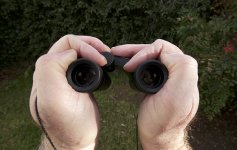WJC
Well-known member
Rico I would be cautious about assuming these people saw a steady and informative image, especially if they were not accustomed to using binos. I have met many people who did not know of the existence of the dioptre adjuster on their binos and just assumed that the unsharp image they saw was typical and as good as it could get. They were amazed when shown how to adjust the dioptre. I have given others binos to try with not only the dioptre adjusted to a stupid setting but also with one eyecup down and one eyecup up. Most people did not question this probably due to a combination of not being sure something was wrong and not wanting to appear ignorant by asking about it. Of course they learned something when shown how to set the eyecups and the dioptre.
I suspect that the people who tried out your higher magnifications just thought a shaky image was normal. Even if they thought 'this shaky image cannot be normal' they may not have commented in case they appeared ignorant or stupid.
Lee
And then we have the old fellow who told me the ship-mounted bino he used during WWII was a “1,000 power.” He didn’t know that he was talking to a Navy Opticalman who had been inside every model ever made and that they were all 20x120 (4.77-inch). Although it probably wouldn't have mattered because he obviously needed bragging rights. Anyway, the SIZE of a bino ALWAYS DETERMINES its magnification ... RIGHT?!
This is just ONE of the MANY reasons why “ultracrepidarian” is such a great word. :cat:
Bill
Last edited:





